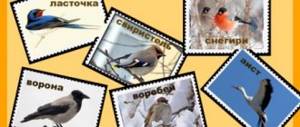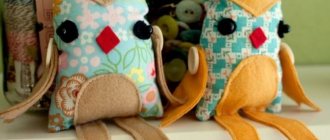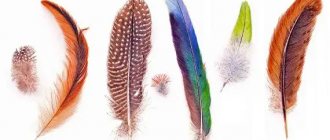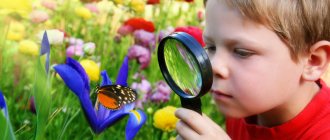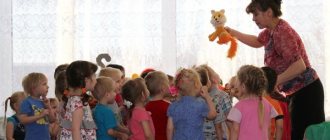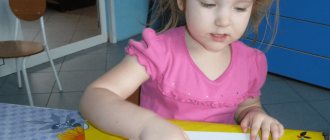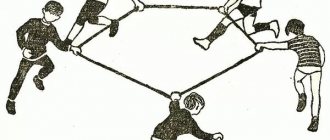For what age and what kindergarten groups is a lapbook suitable?
Of course, preschoolers become familiar with the general concept of “Birds” at an early age: educational classes on this topic are already held in the nursery group. In the younger group, children's knowledge expands: they learn that birds are domestic and wild, and learn to reproduce some bird voices.
However, it is advisable to offer a lapbook on the topic “Wintering and Migratory Birds” to children starting from the middle group. At this age, children learn that different birds are differently adapted to life during the cold period: some fly to warm regions when the cold sets in and then return in the spring, while others spend the winter in their homeland, some near human habitation. A lapbook will allow you to consolidate this information, and will also focus the attention of preschoolers on various aspects of the topic (for example, what kind of food people can offer to birds, interesting information about individual birds, etc.).
It is important that this manual will be relevant for children precisely in the winter, when with the arrival of cold weather, preschoolers will have questions about birds. After all, we do not offer, for example, in the fall a lapbook on the theme “Spring” or “Summer”.
How to make a lapbook of migratory birds. Lapbook “birds”
The implementation of the Federal State Educational Standard requires teachers to introduce more and more new technologies into their practice. One type of new technology is the lapbook. This manual uses various didactic, board, board-printed and speech games. Pictures, coloring pages and other tasks were selected from the Internet. This lapbook is designed for children from 4 to 7 years old. Can be used for speech and cognitive development of preschool children.
This is what my laptop looks like.
It has many interesting pages with various games and tasks. The tasks are in different pockets, books, “accordions”.
On the first title page there are two mnemonic tables about domestic and wild birds.
Didactic exercise “Tell me”
Purpose of the game: To exercise the ability to compose descriptive stories about birds according to the scheme .
Develop monologue speech and memory.
On the second and third pages: games “Domestic, migratory, wintering”, “Whose tail?”, “Who is missing?”
Didactic game
“Domestic, migratory, wintering, waterfowl”
Purpose of the game: Practice classifying birds by species, name them, justify your answer.
Progress of the game: children are given pictures of birds and asked to divide them into four groups (domestic, migratory, wintering, waterfowl).
Didactic game “Whose tail?”
Target:
consolidate ideas on lexical topics “Wintering and migratory birds”, create conditions for activating the vocabulary, consolidate the ability to form possessive adjectives.
Progress of the game:
Younger age. The teacher gives the children the bodies of the birds, and then shows the tails one by one. Children must name “their” bird and choose a suitable tail for it.
Average age. The teacher asks the children to name whose tail is lost.
Older age. Children independently look for the “owner” of the tail and pronounce the name of the bird, saying whose tail it is.
Didactic game "
Who is missing."
Target
: consolidate the ability to recognize and name birds; develop visual memory, attention; develop the ability to form the genitive case of plural and singular nouns.
Material:
cards with images of birds, typesetting canvas - house.
Progress of the game.
The teacher invites the children to look at the typesetting canvas, name all the birds, and close their eyes. He “hides” one or more birds, and the children must guess who the teacher hid.
On the fourth and fifth pages: D/I “The Third Wheel”, “Migration of Birds”, Poems about Birds, card index of games.
Poems about birds.
Target.
Expand your understanding of birds, develop an interest in poetry, and cultivate a love for birds.
Didactic game “
The Third Wheel”
Purpose:
practice the ability to distinguish and classify birds. Develop visual attention, observation, memory, speech.
Progress of the game:
Participants in the game are invited to carefully look at the illustrations depicting birds and say which one is superfluous and explain why.
Didactic game “
Migration of birds”
Purpose:
to practice classifying birds as migratory and wintering, to reinforce in children’s ideas about the methods of birds migrating in a “wedge”, “chain”, “flock”, “shoal”, “straight front”.
Progress of the game:
Children are offered diagrams of bird flights and pictures of birds. Children must classify the birds according to their method of migration.
On the sixth and seventh pages of the NPI “Loto”, a folder with pictures that show how to draw or sculpt birds sequentially, an accordion with puzzles, a learning activity “Birds and Shadows”, a learning activity “Make a story from the pictures”, a book with a didactic exercise “Count the Birds” .
“We draw and sculpt birds”
Target.
To develop interest in visual arts, to help children master and consolidate methods of drawing and sculpting birds, to develop creative abilities and imagination.
Didactic exercise
“Make a story from the pictures”
Target.
Formation of skills in coherent composing of a story based on pictures.
NPI
Lotto
Purpose.
D.:
continue to introduce children to bird species, develop visual perception, attention, and imaginative representation.
Develop children's ability to play while following the rules.
Game task or game rule.
Collect the pictures as quickly as possible.
Game actions.
The presenter invites each player to take one picture. The picture needs to be filled in with 6 cards depicting birds. The presenter shows the card, the player must say whether it is his card or not. You can complicate the game, give players 2 lotto pictures and fill them with cards.
Didactic exercise “Rebuses”
Target.
Develop logical thinking, quick wits, and the ability to solve puzzles about birds.
Didactic game “
Birds and Shadows”
Goal.
Teach children to find given silhouettes. Develop cognitive activity. To develop children's visual perception, attention, and thinking. Develop attention, observation, memory and perseverance.
Progress of the game.
Option 1. The teacher gives the children colored cards with pictures of birds. Invites children to look at them. Next, the teacher shows the shadow of a bird. Children must find, among the available cards, the one that matches the desired silhouette and cast a shadow on the picture they have.
Option 2. (shadows) are laid out on one side of the table
pictures, on the other - color images of pictures. The teacher invites the children to divide the shadows into colored pictures.
Didactic game “
Count the birds”
Purpose: to consolidate the agreement of numerals with nouns, exercise in quantitative calculation.
Progress of the game
: The teacher offers to count the birds, and the children agree on the noun with the numeral: One woodpecker, two woodpeckers, three woodpeckers, four woodpeckers, five woodpeckers, etc.
On the eighth and ninth pages there is an envelope with pictures “What first? What then? ”, a book with proverbs and sayings about birds, a map - diagram “Structure of birds” and an envelope with coloring pages.
Didactic exercise “Who is behind what? What why?"
Target.
Consolidating ideas about the stages of bird development.
Birds coloring pages
Target.
Help children consolidate the names of birds, develop the ability to select color combinations, and practice careful coloring without going beyond the contours.
Proverbs and sayings about birds
Target.
Develop interest in oral folk art.
Didactic exercise “Structure of a bird”
Target. Developing the ability to talk about the structure of birds using a diagram.
On the tenth and eleventh pages: an exercise for the development of logical thinking “Labyrinths”, didactic games “Bird Family”, “Bird Canteen” and “Collect a Picture”.
Didactic exercise “Labyrinths”
Didactic game "
Bird's Dining Room"
Purpose
:
to consolidate knowledge about birds and what they eat, to develop cognitive abilities.
Progress of the game:
Children receive large cards with pictures of birds. The teacher takes turns showing small cards with images of bird food and asks the question: which bird likes to eat bread crumbs, watermelon seeds, rowan berries, etc.
Didactic game “Collect a picture”
Target:
develop perseverance, attention, consolidate children’s ideas about birds, their structure, recognize and name familiar birds, cut-out pictures of birds.
Progress of the game
: children are invited to assemble an image of birds from cut parts (you can include an element of the competition “Who can assemble it faster?”)
Didactic game "Bird Family"
Target:
development of attentiveness and observation of children, consolidation of the names of birds.
Material:
cards with pictures of poultry.
Progress of the game
The teacher invites the children to look at the pictures, name all the birds, and then assemble a bird family.
Exercise “Labyrinth”
Target.
Develop attention, thinking, visual perception, exercise the ability to navigate on a sheet of paper.
Methodological manual for kindergarten
A laptop, or as it is also called a thematic folder, is a homemade folder with a different set of materials on a specific topic. All materials from the laptop are located in various windows, houses and pockets; they contain various parts that the child can take out, rearrange, fold at his own discretion. A laptop helps you study and consolidate the material you have covered. My lepbook “Birds” is designed to study and reinforce this topic for children 4-7 years old. A child can make up a story based on a picture, color a bird, put a picture together from several parts, choose domestic and/or wild, wintering and/or migratory birds from a set of pictures of birds, play bird lotto, find the fourth odd one among the pictures. Using the thematic folder, the child will easily master the studied topic, will be able to consolidate his knowledge and in the future quickly restore the acquired knowledge in his memory.
Goals:
expanding children's knowledge about birds living near us, summarizing children's life observations of birds; fostering a caring attitude towards them. Objectives: to form in children an idea of the birds living near us; learn to recognize migratory and wintering birds; wild and domestic; introduce the parts of the bird’s body, habits, appearance of birds, names of the babies. To give children knowledge that birds are not only wild and domestic, wintering and migratory, but also urban and living outside the city.
Enrich the child’s vocabulary, expand the vocabulary of nouns, verbs and adjectives on the topic. Learn to compose a story based on a picture, speaking in complete sentences, connecting them together according to the topic. Write a descriptive story using an outline. To develop perseverance and accuracy, to instill in children a caring attitude towards nature, to teach them to empathize with our smaller brothers; involve the family in the problem of helping animals; develop cognitive processes (attention, memory, thinking, speech), creative potential of students, communicative functions (ability to work in a group, conduct educational dialogue); building self-confidence; learn to evaluate your own work and the work of the group. The manual can be used to familiarize yourself with the world around you, develop speech, mathematics, and activities.
Nina Frolova
I would like to present to your attention a laptop
“
Migratory Birds
,” which is convenient to use in
working with children
within the framework of the corresponding thematic week.
This lapbook is intended for working with children of senior preschool age
.
The purpose of my laptop
- this is to consolidate and enrich
preschoolers’ ideas about migratory birds
, structural features and life, develop the ability to distinguish and name
migratory birds
, develop attention, memory, thinking, speech.
Information in a laptop
helps in an entertaining way to better remember and understand the material, ensures playful, educational, research and creative activity for all students.
Working with this laptop
a child can compose a story using a mnemonic table, put together a picture from several parts, find an extra fourth among the pictures, be able to come up with the name of a non-existent
bird and recognize the bird by its silhouette
. And also the child will easily master the studied topic, will be able to consolidate his knowledge and in the future quickly restore the acquired knowledge in his memory.
Publications on the topic:
Summary of educational activities with children of senior preschool age. Conversation “Birds are flying south” Conversation “Birds are flying south”. Tasks. To form children's ideas about migratory birds. Reinforce ideas about cold weather.
Summary of joint activities of a teacher with children of senior preschool age. Lapbook “Caring for Indoor Plants” An exciting activity In connection with the implementation of the Federal State Educational Standard for preschool education, every teacher is trying to find new approaches and ideas in their teaching.
I chose the theme “Our Birds” as the theme for my first Lapbook. A laptop, or as it is also called a thematic folder, is a homemade folder.
Lapbook “Autumn” Good day, visitors of my page. I present to your attention the “Autumn” lapbook. This laptop is intended for...
A teaching aid for children of senior preschool age, developed and produced by me. The purpose of creating my lapbook is.
Good evening, colleagues! I would like to bring to your attention a lapbook that I made for the kids back in the spring. A laptop allows children to get to know each other.
Good afternoon, colleagues! I present to your attention a laptop on the topic of migratory birds, which is relevant in autumn and spring. Goal: Formation of environmental.
Irina Mikhailovna Yukhmanova
Good afternoon, colleagues! I present to your attention a laptop
on the topic of
migratory birds,
.
Target
:
Formation of ecological education of preschool children, expressed in a humane and value-based attitude towards the world of migratory birds
, as one of the important components of the ecosystem.
Tasks :
1. Expand and clarify children’s ideas about the diversity of migratory birds
.
2. Develop children’s ability to identify the characteristic features of migratory birds
, the ability to classify them according to a certain criterion.
3. Cultivate a kind, caring attitude towards feathered friends.
This game was made for children in the pre-school group. To make this manual, you needed a little cardboard, colored paper, self-adhesive film, tape and time.
This is what a laptop looks like from the front side
.
If you open the game you will see the following:
In the central part of the laptop
There are pictures with images of
migratory birds
; on the back of the card there is a small description of them:
Children can train their logic and thinking with riddles about migratory birds
. If they have difficulty answering, the pictures will tell them:
This game has a separate pocket with coloring pages of migratory birds
By coloring them, the child will be able to remember the appearance
of the bird
:
In the “Types of Flocks” pocket, the child will be able to find cards with images and names of types of flocks; on the back of the cards, the child will see which birds fly in such a flock
:
Children will be able to train their attention in the maze game “Whose Nose?”:
In the “Collect a Bird” pocket, the child must collect a picture of a migratory bird
:
There is a game on the back of
“Name the Bird”, in which a child can train his memory, logic and intelligence:
Publications on the topic:
Abstract of the educational activity “Migratory birds” in the preparatory group Goal: to continue the formation of children’s ideas about migratory birds. Support children's desire to receive educational information.
Abstract of the GCD in the preparatory group “Migratory Birds” Educational area: Cognition Objectives: educational: to consolidate children’s knowledge about birds, the ability to distinguish them, group them, describe them.
Good evening, colleagues! I would like to bring to your attention a lapbook that I made for the kids back in the spring. A laptop allows children to get to know each other.
Report on the project “Migratory Birds” Goal: to develop children’s ideas about the characteristics of the life of migratory birds, to develop cognitive interest in their native land.
Presentation “Migratory Birds” In the spring we meet migratory birds. For this purpose, I carried out the project “Migratory Birds”. In which we sculpted and designed larks.
Project “Birds of Migratory” Our planet Earth is very generous and rich. Mountains, forests and fields are our dear home, guys. The sun rises early and lights up the day with a ray. Funny.
How to use a lapbook when working with preschoolers
A laptop provides a lot of opportunities for working with preschoolers. You can work with it with a group of children: use it in educational classes, for the development of children's speech) work with poems, riddles, tongue twisters).
In your free time, a lapbook is an indispensable tool for individual work. Children can play educational games, including lotto (in this case there will be several players), solve crossword puzzles, go through mazes, assemble puzzles, and color pictures of birds.
The kids like to look at laptops, look into envelopes, leaf through books, etc. in their free time.
Like any lapbook, the guide “Wintering and Migratory Birds” can be used at home (this is especially true for parents whose children do not attend kindergarten). In this case, the child must be involved in the process of preparing the manual.
Nowadays, when environmental issues take on special significance, manuals on the topic of living nature and caring for it become especially relevant. Therefore, it will be useful for a teacher or parents to find time and make a hand-made guide for preschoolers - a lapbook “Wintering and Migratory Birds”. You can include a lot of useful and interesting information here. The main thing is to approach the work creatively, adopting original design ideas.
Methodological development (preparatory group) on the topic: Lapbook “Wintering Birds”
Lapbook “Wintering Birds”
In connection with the implementation of the Federal State Educational Standard for preschool education, every teacher is looking for new approaches and ideas for teaching activities. So I began to study and use in my work a completely new, interesting, irreplaceable teaching aid - LEPBUK.
A laptop is an interactive homemade book or folder that contains inside many pockets, folding books, pictures, envelopes, windows, doors and other details. A laptop is a game, creativity, learning and exploring new things, repeating and consolidating what has been learned, systematizing knowledge and simply an interesting type of joint activity between parents and children. All lapbook materials correspond to a specific topic and carry educational and developmental functions.
I present to your attention the “Wintering Birds” lapbook.
The central part of the lapbook depicts wintering and migratory birds. The child must find wintering birds, on the right half in the pocket “wintering birds”, he can check himself whether the wintering birds are correct.
Below is a mini-book “How to help wintering birds,” which tells how you can help wintering birds: make a feeder, feed the birds, rules for feeding birds, and what you can and cannot feed the birds.
Next is the mini-book “Types of Feeders”, which presents photographs of feeders made by yourself.
On the left side of the laptop there are mini-books:
- “Poems about Birds” - it contains poems about wintering birds,
- “Riddles about wintering birds” - collected riddles about wintering birds,
- “Children's stories about wintering birds” - on the pages of this book are written children's stories about wintering birds.
Results of using a laptop:
- quick memorization of poems, riddles;
-showing increased interest in the content;
-showing independence when working with a laptop.
nsportal.ru

